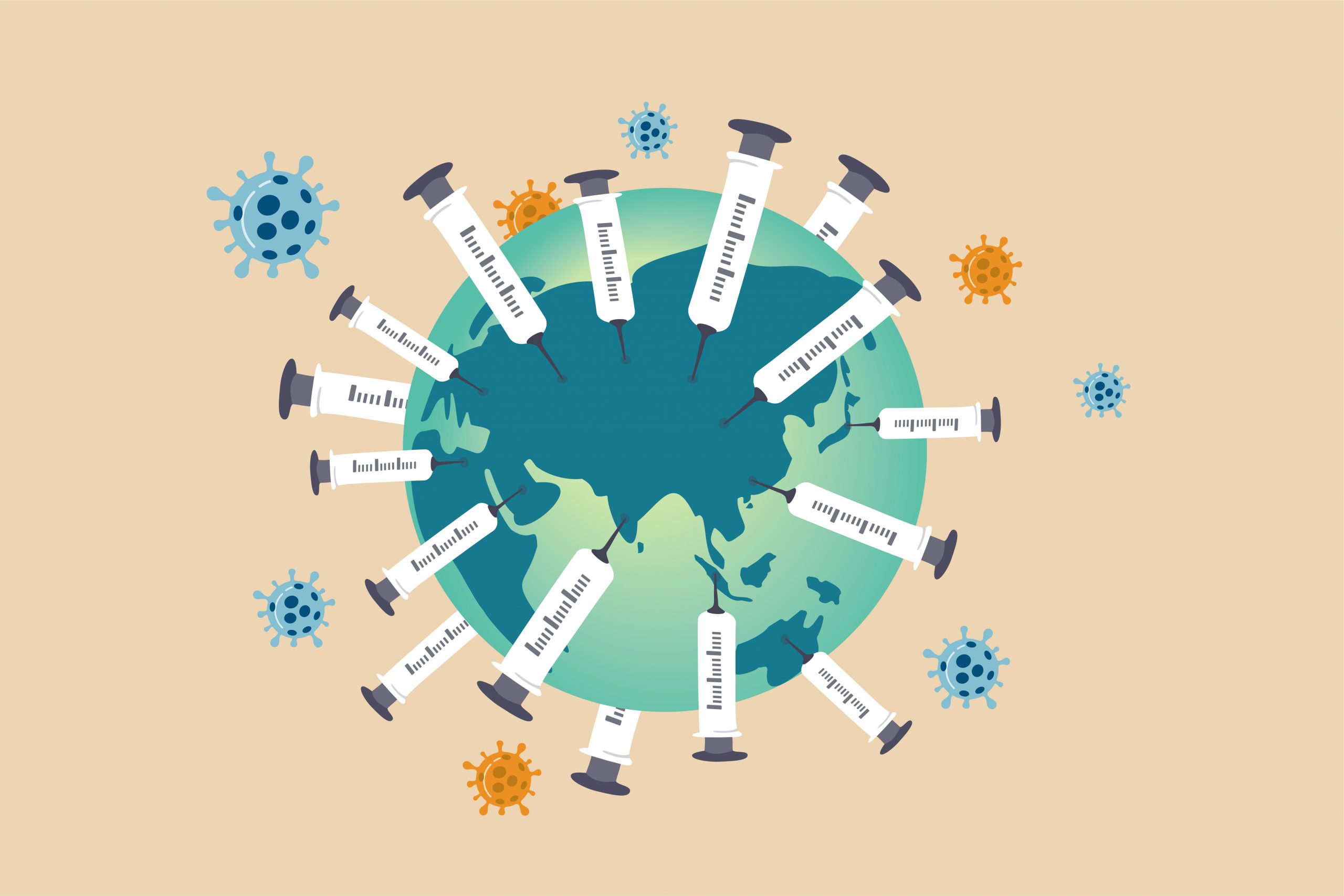“While the TRIPS Waiver is not sufficient to ensure widespread vaccination, it is an essential piece of the puzzle and is not likely to threaten the safety of intellectual property protection in the long run.”
 Intellectual property protection has played an important role in this pandemic. As some have pointed out, without legal protection for innovative ideas, there may not have been such a rapid response to the pandemic – both in terms of testing/ treatment and, most recently, vaccines. Companies like Moderna, in conjunction with research and funding from the National Institutes of Health (NIH), have spent a decade developing key technology that enabled quicker vaccine development than ever before. Without some intellectual property protections in place that provide strong financial incentives to invest in new ideas, innovation like this may never have come to light.
Intellectual property protection has played an important role in this pandemic. As some have pointed out, without legal protection for innovative ideas, there may not have been such a rapid response to the pandemic – both in terms of testing/ treatment and, most recently, vaccines. Companies like Moderna, in conjunction with research and funding from the National Institutes of Health (NIH), have spent a decade developing key technology that enabled quicker vaccine development than ever before. Without some intellectual property protections in place that provide strong financial incentives to invest in new ideas, innovation like this may never have come to light.
Nevertheless, India and South Africa initiated a proposal in October that is gaining traction among like-minded World Trade Organization (WTO) members. This proposal would temporarily suspend certain provisions of the Agreement on Trade-Related Aspects of Intellectual Property (TRIPS Agreement) for products related to COVID-19, including vaccines. What began with a handful of nations has now reached a majority, with 57 national sponsors of the proposal, and over 60 WTO members who are in support.
The undergirding rationale for this TRIPS Waiver, is that traditional intellectual property protection has no place in a global pandemic. While usually we want companies to be able to protect their intellectual property, this emergency context demands shared ideas, technology and know-how. Temporarily waiving the commitment to protect these innovations will allow countries to mobilize generic drug and vaccine producers to manufacture these products without the threat of domestic lawsuits or complaints at the WTO.
This has become especially important in the context of vaccines, given that global demand for these products has outstripped global supply, resulting in grossly inequitable distribution. Furthermore, the primary obstacles continue to include production bottlenecks, financing, and logistics, alongside the exclusive rights granted by patents. The argument here, of course, is that allowing generic producers into the market will ease at least some of these bottlenecks and enable us to vaccinate everyone much more quickly. Indeed, while the TRIPS Waiver is not sufficient to ensure widespread vaccination, it is an essential piece of the puzzle and is not likely to threaten the safety of intellectual property protection in the long run.
How it Would Work
Pharmaceutical companies have spoken out about the problematic nature of the TRIPS Waiver. Suspending intellectual property rights, they argue, will undermine our ability to respond to future pandemics by changing the incentive structure for pharmaceutical companies. If they do not continue to receive the same or similar financial incentives for these vaccines, how could they fund future research essential to responding to future crises? Moreover, if the waiver passes during this pandemic, that increases the likelihood that another waiver may go into effect in the future, threatening long-term pandemic preparedness.
This concern, however, is not as devastating as it may at first seem. If the TRIPS Waiver were to go into effect, each country interested in deploying generic pharmaceutical producers would have to implement that waiver within their own laws. The exact process by which that takes place would depend on the specifics of their laws and policies already in place. A country that does not want to waive those protections does not have to within their own law, and intellectual property holders will retain monopoly rights (and profits) within those countries.
Following domestic implementation, companies with supply capacity will have to attain access to the knowledge, technology and know-how to produce those vaccines. In some cases, that will be quite straightforward. Outside of the context of vaccines, many of the COVID-19 treatments, which are traditional chemical pharmaceuticals, will be relatively easy to reproduce. Even several of the current vaccines in the market use more traditional vaccine technology (like the viral vector and protein subunit types), which generic vaccine producers would be able to replicate. Of course, for newer technologies like the messenger RNA vaccines (Moderna and Pfizer/BioNTech), acquiring the technology and know-how would be much more difficult – some might say impossible – if the innovating companies are not properly incentivized to cooperate.
Admittedly, an intellectual property holder might be concerned with the possibility of losing access to their monopoly rights – especially in countries where they have sufficient pharmaceutical manufacturing capacity to actually take advantage of such a waiver. However, the limits of the TRIPS Waiver and the overwhelming global demand for their products suggests that the impacts on monopoly rents will be minimal at most. Although WTO members have not yet been able to negotiate exact terms of the TRIPS Waiver, it is not likely to have any impact beyond the time when worldwide vaccination is the norm – and it will apply only to products aimed at treating and preventing COVID-19.
Extra Protection for Pandemic Innovators
Vaccine development is extremely expensive and, relative to other pharmaceutical markets, not that lucrative. The combination of high market entry costs and low profits is usually dealt with through a combination of high levels of government investment (at the front end) and high intellectual property protection (at the back end). This minimizes the risks to innovating companies and incentivizes their productivity.
Once vaccines have been created, governments purchase the vaccines through bilateral negotiations for domestic distribution. In this case, both the demand and supply side of the industry are represented by a relatively small number of actors. Since demand for vaccines is not elastic, in that it does not depend on the price, suppliers have an enormous amount of market power.
Given the high costs of vaccine development, and the uncertainties in production, even with government support for research and development, this market power might not be excessive. Indeed, the global public health benefit of vaccines outstrips the investment required to create them. In ordinary times, vaccine creation can cost “from several hundred million to a few billion” dollars, while total revenue for the industry in 2019 was only USD 33 billion – only 2.5 percent of revenues from all pharmaceuticals.
However, the realities of the pandemic have fundamentally shifted the balance governments typically strike between innovation and access to new ideas. Governments have poured up to USD 25 billion into the vaccine industry for rapid research and development and the promise of almost unlimited demand. Even at that steep price, it is a drop in the bucket compared with global cost of the pandemic. While typical profits from the flu vaccine run USD 4 billion to USD 5 billion annually, Moderna and Pfizer are expected to make USD 18.4 billion and USD 15 billion, respectively, in 2021. If COVID-19 becomes endemic and annual booster shots are needed, profits will continue to accrue on an annual basis.
Alternatives to the Waiver
While everyone agrees that more vaccines need to be produced quickly and distributed widely, not everyone agrees that the TRIPS Waiver is the way to accomplish this task.
Many experts point to the positive private and public initiatives already in place to argue that a waiver of intellectual property rights is not necessary and may even be harmful. Moderna, for example, agreed at the outset (in a non-binding statement) to not enforce their patent rights for the duration of the pandemic, although that commitment does not extend to technology and know-how. The producers of the Oxford/AstraZeneca vaccine have pledged to sell their product at cost, forgoing what would be a potentially enormous profit. India’s Serum Institute, the largest vaccine producer in the world, has negotiated a license to make the Oxford/AstraZeneca vaccine and is poised to expand their current facilities even further. Some of the major vaccine companies are cooperating with the World Health Organization’s COVAX facility to produce vaccines for 92 developing countries at a greatly reduced price.
Both the former Trump and current Biden Administrations in the U.S. have invoked the Defense Production Act (DPA) to require pharmaceutical manufacturers to shift production to vaccines and to provide more rapid access to the needed equipment and technology to make that happen. China and Russia have each funded their own vaccines to boost domestic supply, as well as for export.
Meanwhile, the African Union has begun negotiating vaccine purchases with the help of the African Export/Import Bank and the United States has established the Quad Vaccine Initiative with India, Japan and Australia to boost production of vaccines for strategic countries in the Pacific and Southeast Asia.
Perhaps this is enough? The good news is that vaccine rollouts are underway in every region of the world. 381 million doses have been given worldwide, and vaccine producers have, perhaps optimistically, pledged to supply 12.5 billion by the end of 2021. The United States, which so far does not have the best track record for handling the pandemic, is on track to vaccinate the majority of Americans by the summer of 2021. Israel has vaccinated almost two-thirds of its population, and the United Arab Emirates is not far behind. Even Chile has caught up and passed the United States, with more than a third of their population receiving at least one dose of a vaccine.
Not Quite Enough
The stories of challenging vaccine rollouts in the developed world, however, look like a hiccup compared to the obstacles developing countries will face in immunizing their populations.
Developed countries, accounting for just over 10% of the global population, have pre-purchased more than 60% of the vaccine doses pledged by 2021. Meanwhile, the developing world is struggling to get access to even a fraction of their population. The COVAX Facility is seeking to vaccinate 20% of developing country populations by the end of 2021, but currently only has one-third of the funding it needs.
Moreover, despite widespread political support, the very countries that tout the COVAX facility as the best mechanism for widespread vaccine access have actively undermined the COVAX effort by pre-purchasing more vaccines than their total population. Vaccine manufacturers are blaming the U.S. national effort through the DPA for disrupting supply chains and creating shortages of raw materials for vaccines production. At the same time, pharmaceutical companies holding key COVID-19-related patents have sought to punish countries by threatening sanctions through U.S. law for issuing compulsory licenses during the crisis. This is despite the fact that these licenses are permitted under the TRIPS Agreement for use in a global emergency such as this.
In a world where the standard approaches are not doing enough, the TRIPS Waiver is a necessary first step toward facilitating increased, rapid production of vaccines. Rather than undermining the value of innovation or making it less likely in the future, the proposal demonstrates how, for many countries, the traditional balance between innovation and access has tipped toward prioritizing access for the time being.
Future pandemics will be met with the same, or likely even more, public financial support for research and development, which will flow once more toward those innovator companies poised to take vaccine creation to the next level.
Image Source: Deposit Photos
Vector ID:443749080
Copyright:eamesBot

![[IPWatchdog Logo]](https://ipwatchdog.com/wp-content/themes/IPWatchdog%20-%202023/assets/images/temp/logo-small@2x.png)

![[[Advertisement]]](https://ipwatchdog.com/wp-content/uploads/2023/01/2021-Patent-Practice-on-Demand-1.png)
![[Advertisement]](https://ipwatchdog.com/wp-content/uploads/2024/03/IP-Copilot-Apr-16-2024-sidebar-700x500-scaled-1.jpeg)
![[Advertisement]](https://ipwatchdog.com/wp-content/uploads/2024/04/Patent-Litigation-Masters-2024-sidebar-early-bird-ends-Apr-21-last-chance-700x500-1.jpg)

![[Advertisement]](https://ipwatchdog.com/wp-content/uploads/2021/12/WEBINAR-336-x-280-px.png)
![[Advertisement]](https://ipwatchdog.com/wp-content/uploads/2021/12/2021-Patent-Practice-on-Demand-recorded-Feb-2021-336-x-280.jpg)
![[Advertisement]](https://ipwatchdog.com/wp-content/uploads/2021/12/Ad-4-The-Invent-Patent-System™.png)







Join the Discussion
No comments yet.